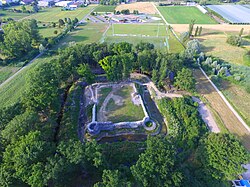
Amadeus V was Count of Savoy from 1285 to 1323.

Faucigny is a commune in the Haute-Savoie department in the Auvergne-Rhône-Alpes region in south-eastern France.
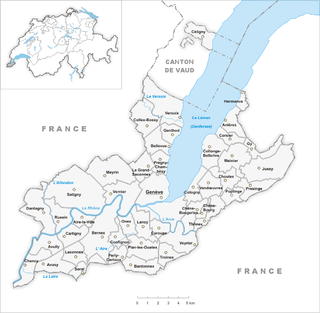
The Canton of Geneva, officially the Republic and Canton of Geneva, is one of the 26 cantons of the Swiss Confederation. It is composed of forty-five municipalities, and the seat of the government and parliament is in the City of Geneva.

Thonon-les-Bains, often simply referred to as Thonon, is a subprefecture of the Haute-Savoie department in the Auvergne-Rhône-Alpes region in Eastern France. In 2018, the commune had a population of 35,241. Thonon-les-Bains is part of a transborder metropolitan area known as Grand Genève. It is situated on the shores of Lake Geneva.

Chillon Castle is an island medieval castle located on Lake Geneva, south of Veytaux in the canton of Vaud. It is situated at the eastern end of the lake, on the narrow shore between Montreux and Villeneuve, which gives access to the Alpine valley of the Rhône. Chillon is amongst the most visited medieval castles in Switzerland and Europe. Successively occupied by the House of Savoy, then by the Bernese from 1536 until 1798, it now belongs to the State of Vaud and is classified as a Swiss Cultural Property of National Significance. The Fort de Chillon, its modern counterpart, is hidden in the steep side of the mountain.

The following are the 45 municipalities of the canton of Geneva, as of 2017.
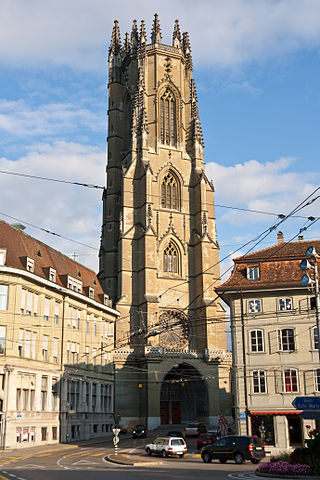
The Diocese of Lausanne, Geneva and Fribourg is a Latin Catholic diocese in Switzerland, which is exempt. The original diocese of Lausanne was a suffragan of the archdiocese of Besançon, through the 18th century. The diocese of Geneva was a suffragan of the archdiocese of Vienne.

A White Lady is a type of female ghost. She is typically dressed in a white dress or similar garment, reportedly seen in rural areas and associated with local legends of tragedy. White Lady legends are found in many countries around the world. Common to many of these legends is an accidental death, murder, or suicide, and the theme of loss, betrayed by a husband or fiancé, and unrequited love.
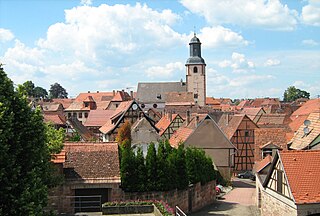
Bouxwiller is a commune in the Bas-Rhin department, Alsace, Grand Est, northeastern France. Likely meaning "Bucco's land", Bouxwiller is the capital of the Bouxwiller canton and is located within the Saverne arrondissement about 34 kilometres (21 mi) northwest of Strasbourg.
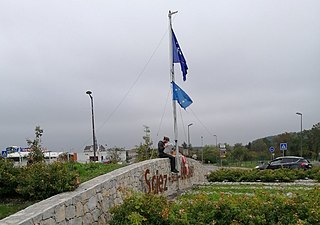
Sciez is a commune in the Haute-Savoie department in the Auvergne-Rhône-Alpes region in south-eastern France. Sciez forms part of a transborder agglomeration known as Grand Genève.

Amadeus III was the Count of Geneva from 1320 until his death. He ruled the Genevois, but not the city of Geneva proper, and it was during his time that the term "Genevois" came to be used as it is today. He was the eldest son and successor of William III and Agnes, daughter of Amadeus V of Savoy. He played a major rôle in the politics of the House of Savoy, serving consecutively as regent and president of the council, and also sitting on the feudal tribunal—one of three tribunals of the Audiences générales—of the Duchy of Aosta.

The Château de Helfenstein is a ruined castle in the commune of Philippsbourg in the Moselle département of France.
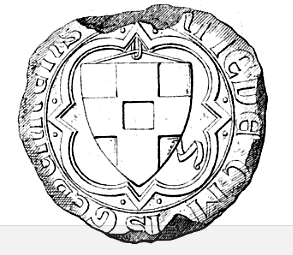
Amadeus II was the Count of Geneva, which included the Genevois, but not the city of Geneva, from 1280 to 1308. He was the second son of Count Rudolf and succeeded his heirless brother Aymon II.

The Château de La Bâtie-Seyssel is a castle in the commune of Barby in the Savoie département of France.

The Diocese of Geneva was a Latin Church ecclesiastical jurisdiction or diocese in part of Switzerland and Savoy from 400 to 1801, when it merged with the Diocese of Chambéry. The merged diocese was later broken up, due to changes in national boundaries. The diocese of Chambéry lost Swiss territory to the Diocese of Lausanne, Geneva and Fribourg.

Nicolas Cilins is an artist living in Geneva, Switzerland, working across the disciplines of visual arts, filmmaking, and performance art. His works are included as part of several public collections, such as the Institut für Film und Videokunst in Germany, the Fonds régional d'art contemporain in France, the Kunstmuseum Bern, the Fonds cantonal d'art contemporain, and the Fonds municipal d'art contemporain de Genève in Switzerland. Cilins became a laureate of the Swiss Art Awards in June 2018, and a laureate of the Geneva Art Awards in September 2020.

Seyssel is an ancient French family which is first mentioned in Savoy in the thirteenth century and probably dates back some time earlier. The name derives from city of Seyssel, and the family's various branches held the titles of viscounts, earls, barons and marquises over the course of time. Its members were positioned in the first rank at the court of the Counts of Savoy and the bishops of Geneva. Today there are branches of the Seyssel in Italy, Bavaria, Austria and France.
William III of Geneva was the Count of Geneva from 1308 to 1320. He was the son of count Amadeus II of Geneva, and Agnès, daughter of John, Count of Chalon.

The Château de Saint-Michel-de-Maurienne is a 13th-century castle in the commune of Saint-Michel-de-Maurienne Savoie département of France.

The Bâtie-Beauregard - which can be translated from French as "building with a beautiful gaze" - is a ruined hill castle in the municipality of Collex-Bossy and one of the few remnants of a medieval castle in what is now the Canton of Geneva in Switzerland.
